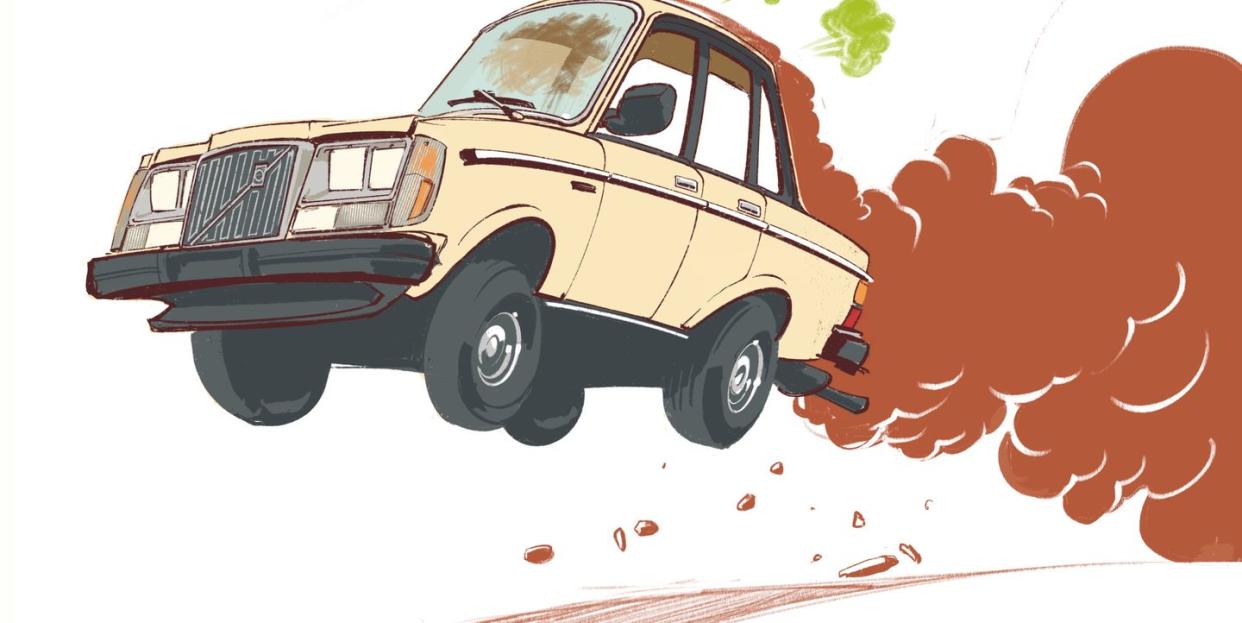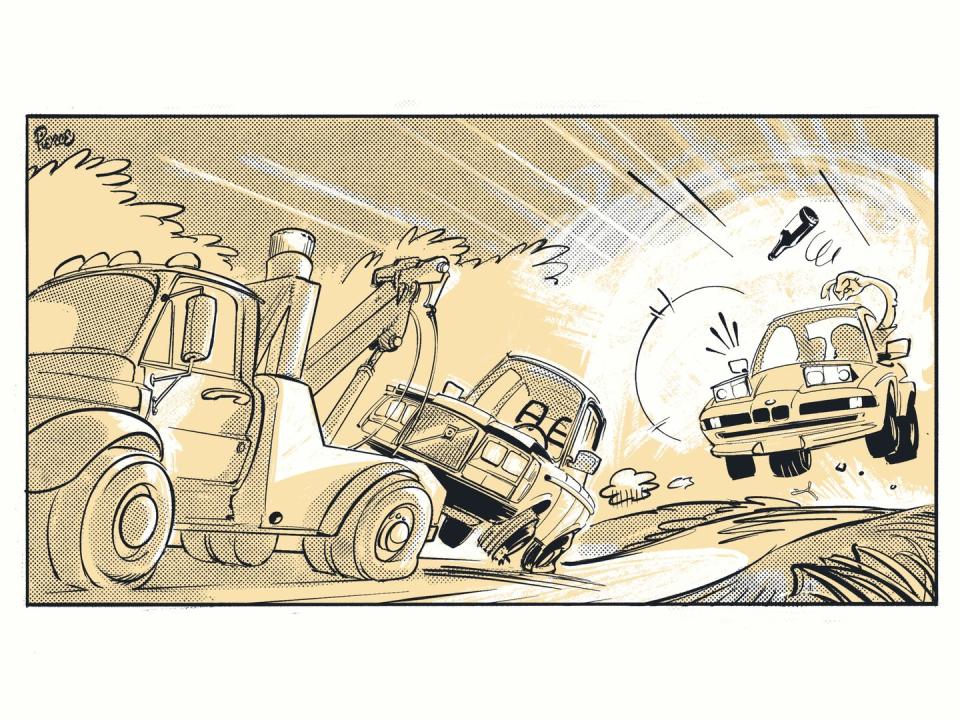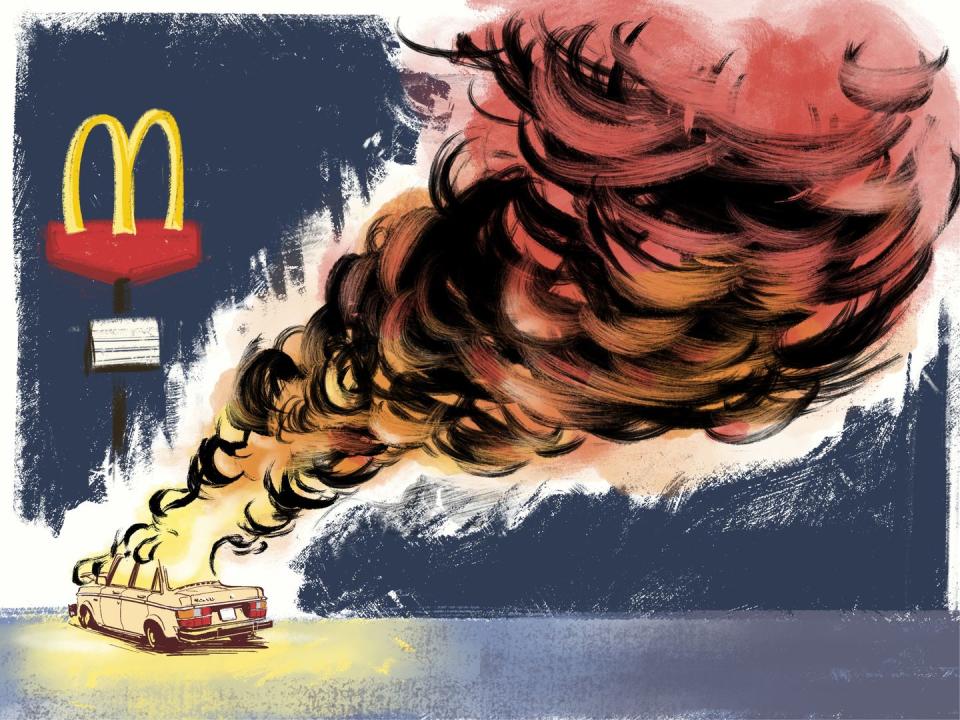The Volvo 240 That Refused to Die

Like most firsts—first words, first kiss, first job—your first car will occupy a place of at least minor significance in your personal history. It’s a meaningful rite of passage, and perhaps a harbinger of your ability to navigate adulthood without causing important things to explode. Maybe the story of your first car is one of sweetness and dedication and optimism—"Sadie," the beater Oldsmobile you thoughtfully named and disproportionately cherished until her transmission went. You mourned her. She was a hunk of mindless metal, but she was your hunk.
My hunk was a brave and nearly indestructible Volvo, which I called "the Volvo," and which I treated like absolute crap for as long as it would let me.
The Volvo—a 1984 240, nominally tan—was salvaged from a tow lot in the DC suburbs in 1997. My uncle owned an adjacent body shop; this seemed to him like a reasonable project, and the kind of sturdy and ultra-cheap tank suited to a new driver. I shared the news of my first vehicle with one car-knowing friend. I, a non-car-knower, was encouraged when he said "oh, cool!" When he finally laid eyes on the car, a week or two later, he pulled a face and said, "yeesh." It was an extremely unsexy vehicle.
The car’s paint job had long ago bleached to a sickly off-white. The lentil-colored leather seats were cracked and split and had the texture of dad’s five o’clock shadow. The floor and door panels were upholstered in foul, matted shag carpet. The manual sunroof opened and closed with great effort—always audibly registering its displeasure at the task—until the handle broke off one day with the sunroof half-open. I went from embarrassed at not having a car of my own to pretending I still did not have a car, in order to avoid having to show the car to friends and girlfriends. Escaping the school parking lot unnoticed became an ordeal, in no small part because the Volvo ran loud and left behind a billowing Pig-Pen-esque cloud wherever it went.
The cloud had to do with a leak somewhere in the cooling system. Coolant would drip onto the hot engine, vaporize, and flow out through the seams around the hood. It found its way inside, coming into the car through the dash vents, coating the interior. These "smoke events" went from annoying to dangerous whenever I used the windshield defroster, which caused antifreeze haze to condense in my line of sight and obscure the road. Wiping the coating away by hand only created an oily mess; before long, my brother and I learned to keep a spray bottle of window cleaner and a roll of paper towels in the car, and it became the job of the front seat passenger to keep the windshield reasonably clean, lest we die in a fiery wreck. Driving the Volvo alone meant eschewing the defrost altogether, as a rule, which meant dealing with an only-slightly-less-dangerous version of the same problem. Driving with my head stuck out the window was not uncommon.
It being a Volvo, the car otherwise mostly held up its end of the bargain, lung-coating miasma of acrid coolant vapor notwithstanding. It chugged along, grouchy but reliable, for the better part of two years, despite the constant existential threat caused by my total indifference toward its well-being. I had the oil changed once in 24 months, during which I must’ve added at least 30,000 miles to the Volvo’s odometer, already up over 200,000. I never replaced, rotated, or even aired up the tires, never serviced or checked the brakes, could never have even identified the reservoir for power steering fluid. When the headlights and taillights suddenly blinked off one night due to a mysterious electrical failure, I solved the problem by running the high beams, riding the brakes, and making an effort to drive the Volvo as little as possible after dark. Before long the brakes were squealing, an embarrassing signal of the Volvo's approach that soon devolved into a nightmarish metal-on-metal grinding sound. Still I left them alone, and still the car managed to grumble to a stop as needed.
My abuse of the Volvo was not entirely through passive disrepair. Driving home from my girlfriend’s house in the wee hours in winter 1997—an impractical 20-mile journey, made worse by a desperate need for sleep—I dozed off in the left lane of the Capitol Beltway. This scared me, and so I decided to get off the road, but in my addled condition I made no effort to check for other drivers before changing lanes. I had to swerve to avoid side-swiping a Civic, and when I jerked the wheel back, the Volvo fishtailed. The front left tire, which by then was as bald and smoothly tender as baby’s skin, shredded and blew, and suddenly I was pointed at the median. Volvos are not built to fly, but it turns out you can catch some bitchin' air if you hit a Jersey wall at just the right angle and speed. The landing is hard, though. The impact blew out two more tires and sent my head crashing into the A-pillar. The Volvo, now largely beyond my control, careened across four lanes, throwing up sparks the whole way, and thudded into the right shoulder guardrail, where it ground to a halt. An hour later, the tow truck that was hauling it to the same body shop where it had been so recently reborn was rear-ended by the blind-drunk driver of an 8-series BMW.

That was not the Volvo’s death, though it should've been. New tires and some bare-minimum body repairs brought it home within a month; days later, still scarred and twisted from the Beltway misadventure, the Volvo’s hood jostled loose from its latch, popping open while I was driving quite fast on a rural road. The wind blew the hood flat against the windshield, mangling the hinges and bending hideous cowlicks into both top corners of the hood itself. I jammed the brakes and parked in the middle of the road long enough to bungee the hood back down, then set off again. The Volvo obediently limped onward ahead of its telltale coolant fog, more disfigured than ever. By now I think it was eager for the release of death. Still, I needed the car, so I kept on driving and neglecting it.
This conflict resolved itself spectacularly in the parking lot of a McDonald’s in the fall of 1998. I was munching a Big Mac and listening to a CD with the engine off when I finally registered that the latest smoke event had not abated, and had, in fact, intensified. Suddenly very alert, I noticed, to my alarm, that the paint on the hood was rising off the sheetmetal in a huge low bubble, and that flames were starting to lick out from the fenders. By the time I hung up the payphone in the McDonald’s, the front of the car was engulfed; by the time the fire department arrived, the Volvo was a roaring conflagration, the parking lot filling up with delighted gawkers. What was eventually hauled out of that lot was a charred black rectangle of shriveled metal and melted rubber. The reek and smoke of the Volvo’s viking funeral hung over that section of town into the following morning. It left behind on the asphalt an accursed slick of goo that was still detectable months later. I’d had time to rescue from the inferno my french fries and my CD; instead, for some completely unfathomable reason, I saved the stereo’s detachable face, pointlessly. God knows how many old fast-food wrappers fueled the fire.

The Volvo earned its memorable death, but like a lot of first cars, what it really deserved was a longer, better life at the hands of a more conscientious owner. The poor thing coughed to life each morning through crippling inattention and brutal mistreatment until it was finally too dried up and busted to do anything but burn. In the process, a dipshit teenager learned what it means to exchange care for freedom—and learned, too, how unready he was to negotiate that transaction on his own.
It was most of a year before I could afford another car. In between I bummed rides, and found myself bitterly lamenting the loss of the Volvo I’d neglected to death.
Chris Thompson was a writer at Deadspin until, well, y'know. He has written for Gawker and Vice, and can be found on Twitter @MadBastardsAll.
You Might Also Like

